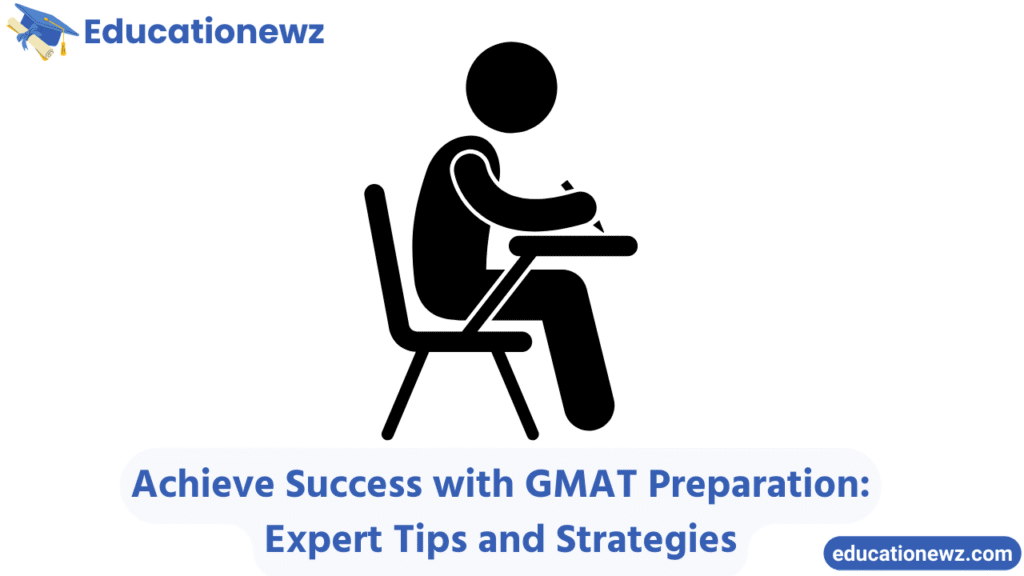Effective GMAT Preparation involves a structured study plan, consistent practice with official resources, time management, and focused improvement on weaker areas to achieve a competitive score.
The GMAT (Graduate Management Admission Test) is a critical exam for students aiming to secure admission to prestigious MBA and business programs worldwide. Excelling in this test requires strategic preparation and dedication. This detailed guide will walk you through essential steps, resources, and tips to achieve your target score.
What Is GMAT Preparation?

The GMAT is a computer-adaptive test that assesses a range of critical skills essential for success in business schools, including analytical writing, quantitative reasoning, verbal reasoning, and integrated reasoning. With over 7,700 programs worldwide relying on GMAT scores for admissions, a strategic and comprehensive preparation plan is key to achieving a competitive score.
Success on the GMAT requires more than just familiarity with the exam’s structure; it demands a strong foundation in each of the four sections. Students should focus on honing their quantitative skills by mastering algebra, geometry, and word problems, while also improving their verbal reasoning through consistent practice in reading comprehension and critical reasoning. Additionally, the integrated reasoning section tests the ability to analyze complex data, making it vital to develop strong data interpretation skills.
To perform well, students should focus on using reliable study resources, including official GMAT prep materials, like the GMAT Official Guide, practice tests, and online tools from reputable prep companies such as Manhattan Prep and Kaplan. These resources provide high-quality practice questions and strategies directly from the test makers.
Regular practice with real GMAT questions is essential for improving time management skills and building the stamina required for the 3-hour exam. Creating a study plan that incorporates daily study goals, mock tests, and reviews of performance will help students stay on track and improve their weak areas. With a clear, focused approach, students can confidently tackle all sections of the GMAT and achieve their target score.
Understanding the GMAT Structure
The GMAT is a comprehensive exam divided into four distinct sections, each evaluating critical skills needed for success in business school and beyond:
- Analytical Writing Assessment (AWA): This section tests your ability to think critically and communicate your ideas clearly. You’ll analyze an argument, identifying its strengths and weaknesses, and then construct a well-reasoned critique. Your performance is scored on your ability to present coherent, logical thoughts in writing.
- Integrated Reasoning (IR): The IR section assesses your ability to analyze complex data from multiple sources, including graphs, tables, and texts. This part of the exam is designed to evaluate your data interpretation skills—vital for tackling real-world business problems where you have to synthesize information from various formats.
- Quantitative Reasoning: This section measures your problem-solving skills and ability to reason mathematically. Expect questions on arithmetic, algebra, and geometry. It tests your ability to work with numbers and apply mathematical concepts to solve problems efficiently and accurately under timed conditions.
- Verbal Reasoning: Here, you’ll demonstrate your ability to understand and evaluate written material. The section focuses on reading comprehension, critical reasoning, and sentence correction, challenging your ability to extract key ideas and evaluate arguments logically.
Key Features of the GMAT:
- Total Exam Duration: 3 hours and 7 minutes.
- Score Range: The total score ranges from 200 to 800. Most top business schools expect candidates to score at least 650, though the ideal score varies depending on the program.
In total, mastering the structure of the GMAT is critical for crafting an effective preparation strategy. Understanding the purpose and challenges of each section will help you target specific areas for improvement and optimize your study approach.
Steps for GMAT Preparation

Create a Detailed Study Plan
Preparing for the GMAT requires careful planning and commitment. Start at least 4-6 months before your exam date. A well-structured study plan will ensure you cover all sections and allocate extra time for your weaker areas.
-
- Daily Goals: Dedicate 2-3 hours daily to focused study sessions.
- Weekly Targets: Set specific goals to complete sections each week, such as tackling Quant on Mondays, Verbal on Tuesdays, and Integrated Reasoning on Wednesdays.
- Track Progress: Use a calendar or app to measure progress and make adjustments as needed.
Use High-Quality GMAT Prep Books
To ensure a solid foundation, rely on trusted and well-reviewed GMAT prep books. These books not only provide practice questions but also offer in-depth explanations and strategies.
- The Official Guide for GMAT Review: The most authoritative source, featuring real past questions and detailed explanations.
- Manhattan Prep Series: Offers deep dives into specific concepts and advanced strategies for mastering each section.
- Kaplan GMAT Prep: This resource includes six full-length practice tests, plus personalized study plans to help you focus on your unique needs.
- Veritas Prep Complete Course: This resource combines video lessons and interactive exercises for a more holistic preparation approach.
These materials ensure that you’re practicing with questions that closely resemble the actual GMAT, helping you build familiarity and confidence.
Take Diagnostic and Practice Tests
Diagnostic tests should be your first step to identify your strengths and weaknesses. They give you a baseline score, allowing you to create a personalized study plan.
- Free GMAT Diagnostic Tests: Use these to pinpoint areas that need attention.
- Full-Length Practice Tests: Simulate actual exam conditions to improve time management and build stamina. Regular full-length tests will help you track your progress.
- Advanced Practice Exams: Once you’re familiar with the format, use more challenging tests (e.g., GMAT Practice Tests 3-6) to ensure you’re fully prepared.
Time yourself while taking practice exams to replicate the pressure of the actual test and improve pacing.
Master the Quantitative and Verbal Sections
Success on the GMAT relies heavily on strong performance in both the Quantitative and Verbal sections. Here’s how you can target these key areas:
-
- Quantitative: Focus on number properties, arithmetic, and algebra. The GMAT tests fundamental mathematical concepts, so it’s crucial to become comfortable with these topics. Use the official GMAT question banks to practice various problem types.
- Verbal: Strengthen your skills in grammar, reading comprehension, and critical reasoning. Books like the PowerScore GMAT Bibles are excellent resources for in-depth study. Regularly practice with GMAT verbal reasoning questions to improve your comprehension and ability to logically analyze written arguments.
Focus on Integrated Reasoning (IR)
The Integrated Reasoning (IR) section is often challenging for test-takers because it requires interpreting data from multiple sources—tables, graphs, and texts. This section tests your ability to synthesize complex data, which is a valuable skill in business decision-making.
-
- GMAT Official Data Insights Guide: This is a must-have for mastering the IR section, offering insights into different question types and strategies for tackling them.
- Practice IR Questions: Use official GMAT IR practice questions to get comfortable with interpreting complex information quickly.
Regular Review and Adaptation
Reviewing your mistakes and adapting your strategy is a crucial part of successful GMAT preparation.
-
- Analyze Mistakes: After each practice test or session, spend time reviewing your mistakes to understand where you went wrong. This will help you avoid repeating the same errors.
- Adjust Your Strategy: If you’re struggling with timing, practice faster or use quicker problem-solving techniques. If accuracy is your concern, spend extra time on understanding the concepts and revisiting difficult questions.
- Simulate Exam Conditions: As you approach your exam date, practice under timed conditions to ensure you’re ready for the real thing.
By following these targeted steps, students can build a comprehensive GMAT preparation strategy that maximizes their strengths and minimizes weaknesses, leading to a competitive score on test day.
Tips for Effective GMAT Preparation
- Start Early: Avoid last-minute cramming by beginning preparation at least six months prior.
- Use Online Platforms: Platforms like Magoosh, Kaplan, and Princeton Review offer online courses, adaptive tests, and video lessons.
- Join a Study Group: Collaborating with peers can provide motivation and new insights.
- Maintain Consistency: Daily study sessions yield better results than sporadic efforts.
- Work on Weaknesses: Prioritize sections where you struggle to ensure balanced scores.
Sample GMAT Study Plan (Table)
| Week | Focus Area | Key Resources | Goal |
|---|---|---|---|
| 1 | Diagnostic Test | GMAT Official Guide | Identify strengths and weaknesses. |
| 2-3 | Quant Fundamentals | Manhattan Prep Quant | Master arithmetic and algebra basics. |
| 4-5 | Verbal Strategies | Kaplan GMAT Verbal Guide | Improve grammar, reasoning, and comprehension. |
| 6 | Integrated Reasoning | GMAT IR Question Bank | Practice graphical and tabular reasoning. |
| 7 | Practice Full Tests | Veritas Prep Online Tests | Simulate test-day conditions and analyze performance. |
| 8 | Review and Adjust | Personal Notes and Guides | Focus on weaknesses and refine timing strategies. |
Challenges and Solutions in GMAT Preparation
Problem: Struggling with Time Management
Solution: Use time-bound practice sessions and attempt timed mock tests regularly. Develop a pacing strategy for each section.
Problem: Low Confidence in Quant or Verbal
Solution: Focus on foundational concepts using specialized guides and take advantage of video tutorials for clarity.
Problem: Burnout or Lack of Motivation
Solution: Include breaks in your study schedule, and remind yourself of long-term goals like MBA admissions or career prospects.
Benefits of Excelling in the GMAT

Access to Top Universities
The GMAT is a critical part of the admissions process for over 7,700 graduate business programs worldwide. Top-ranked schools, such as Harvard Business School, Stanford, and the University of Pennsylvania, place significant weight on GMAT scores when evaluating candidates. A strong GMAT score can open doors to prestigious programs, providing an opportunity to study with top professors, network with talented peers, and gain access to an elite education that boosts career prospects.
Scholarship Opportunities
High GMAT scores can significantly increase your chances of securing scholarships and financial aid. Many universities and business schools offer merit-based scholarships for students with exceptional scores. For example, schools like INSEAD and the University of Chicago offer substantial scholarships for candidates who demonstrate excellence on the GMAT. Additionally, various private organizations and foundations provide GMAT-based awards, reducing the financial burden of graduate school and making education more accessible.
Enhanced Career Prospects
Beyond admissions, excelling in the GMAT can also boost your career prospects. Employers highly value the skills tested by the GMAT, such as critical thinking, problem-solving, and quantitative reasoning. These competencies are crucial in many industries, especially finance, consulting, and management. A strong GMAT score signals to potential employers that you have the analytical skills and intellectual rigor to excel in complex, high-pressure environments. Companies often look for candidates who have the same problem-solving abilities the GMAT tests, making a high score a valuable asset in your professional journey.
By excelling in the GMAT, students not only improve their chances of gaining admission to top-tier programs but also unlock opportunities for financial support and career advancement, making it a powerful tool for long-term success.
Frequently Asked Questions (FAQs)
1. How long does it take to prepare for the GMAT?
On average, students spend 3-6 months preparing, with 2-3 hours of daily study.
2. What is a good GMAT score for top business schools?
A score of 650+ is competitive, but top schools may require 700 or higher.
3. Are online GMAT prep courses effective?
Yes, platforms like Magoosh and Kaplan provide personalized study plans, mock tests, and video lessons.
4. How often can I take the GMAT?
You can take the GMAT up to 5 times a year, with a 16-day gap between attempts.
5. Can I prepare for the GMAT without coaching?
Yes, with the right resources and self-discipline, many students excel through self-study.
Final Thoughts
GMAT Preparation is a journey requiring dedication, strategic planning, and consistent effort. By leveraging high-quality resources, maintaining a structured study schedule, and practicing regularly, students can maximize their chances of achieving a stellar score. Remember, the GMAT isn’t just about intelligence—it’s about preparation and perseverance. Take your first step today and set yourself on the path to success.
For further insights, explore resources like GMAT official practice questions, diagnostic tests, and expert guides to ensure a comprehensive preparation experience. Please follow our blog Educationewz.



